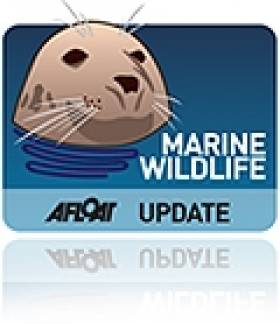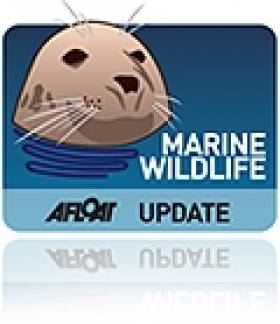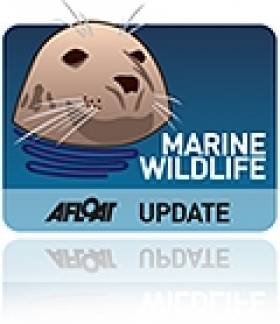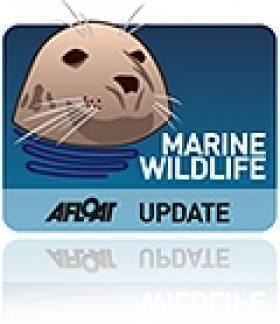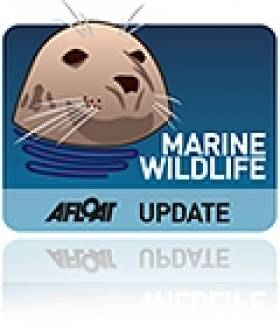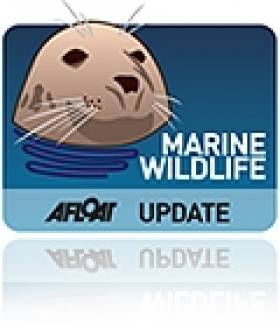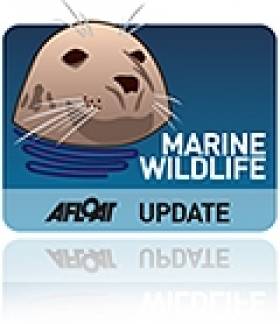Displaying items by tag: marine wildlife
Dutch Step In To Keep Seal Rescue Centre Open
#MarineWildlife - Courtown's seal sanctuary has been saved from closure after Dutch counterparts stepped in to help fill a key vacancy over maternity leave.
As the Wexford People reports, Sonja Ciccaglione has now been seconded as temporary manager of Seal Rescue Ireland's Wexford base.
And she joined the group's volunteers at the latest release of rehabilitated seals last weekend.
Luckily for the staff-strapped marine wildlife centre, it's a quiet period with only a couple of seals remain in residence – but donations from the public are always welcome.
Irish Boy's Wish To Train Killer Whale Comes True
#MarineWildlife - Make-A-Wish Ireland brought six-year-old Ondrej Byrtusova's dreams to life when they whisked him and his family away to Florida to train a killer whale, as the Irish Independent reports.
Ondrej – who was born with Hypoplastic Left-Heart Syndrome – was given the opportunity by the Irish charity to teach a few tricks to orca Malia, who is described as "sweet and playful".
“It was the nicest moment ever when I saw my son so happy and joyful,” said his mother Vlasta. “I am very proud of him that he did it.
"He was absolutely brilliant when he trained Malia showing her how to turn, kiss him, say yes and no, wave and splash, shake her tongue and blow bubbles."
It marked the first ever holiday for the youngster, who has endured years of open heart surgeries.
And while his prognosis is unclear, his family say they are making the most of their time together.
The Irish Independent has more on the story HERE.
Are 'Killer Seals' Feasting In British Waters?
#MarineWildlife - Are 'killer seals' feasting on porpoises off the British coast? Mail Online seems to think so – and presents some shocking evidence.
The video above appears to show a grey seal tearing at the flesh of a porpoise it had killed off Pembrokeshire recently.
While it's not rare to see such seals attack other marine mammals in continental Europe, this is the first time they've been spotted anywhere near Britain or Ireland.
Dafydd Rees, who works with a wildlife cruise company and shot the footage, said he'd "never seen anything like it before" on that stretch of coast.
Britain is already home to nearly half the world's entire population of grey seals. But those resident locally have never before been known to eat anything more than fish.
Experts fear, however, they they may be developing a taste for porpoises caught in fishing nets – and graduating from weakened specimens to healthy young porpoises for their energy-rich layer of fat.
And it's prompted some fears that people swimming near seals might be next on the menu!
Mail Online has more on the story HERE.
Akrlow Seal 'Sammy' Rescued Near Rocky Shoreline
#MarineWildlife - On Friday morning (3 April) Arklow RNLI was made aware of a seal apparently caught in fishing gear close to the Arklow Harbour entrance.
Two of Arklow RNLI’s team went to the area to ascertain if it was feasible to launch the lifeboat to rescue the weary marine mammal, identified locally as Sammy - the subject of a previous rescue some 18 months ago when still a pup.
Due to conditions in the area and due to the proximity of the shoreline and an ebbing tide at the location, it was decided it was inadvisable to launch the Ger Tigchelaar.
Because of the trapped animal's proximity to the shore, and to eliminate the further risk of any members of the public entering the water to save the seal, it was decided instead to try to rescue the animal from a smaller rescue craft.
Two of Arklow RNLI’s volunteers, station mechanic Michael Fitzgerald, and Brian Heaney, went to sea to the aid of the tiring animal.
After hauling in the fishing gear, the exhausted and stressed seal was moved to an area where it could make for the shore to rest and was then cut loose from the fishing gear.
The seal had a short break on the lower rocks of the shoreline before making for open water.
Speaking following the incident, Fitzgerald said: “Luckily we were able to get to the seal in time to save it.
"When members of the pubic come across injured or stressed animals like this trapped in fishing gear or injured, they should inform the authorities immediately, they should never enter the water to try to save the animal.
"They should always leave this to persons who are experienced and have the right equipment to carry out the rescue safely. Always respect the water.”
Beached Minke Whale Is Furthest Inland Ever Recorded
#MarineWildlife - A minke whale who beached along a river far upstream from Kenmare has been rescued thanks to the timely response of locals.
As RTÉ News reports, it's believed that the whale - found some 3km from the Kerry coastal town along the River Roughty – is the deepest inland such marine wildlife has ever been found in Ireland.
Two local boats guided the lone whale back towards the sea after tireless effort by community volunteers to keep it alive out of the water during low tide.
New Revelations On Whale Communication
#MarineWildlife - Following yesterday's news that porpoises hunt by 'sound searchlight' comes this similarly remarkable video report from the BBC that reveals a new breakthrough in understanding how cetaceans communicate.
Studies by researchers at Washington, DC's Smithsonian Institution have identified specific differences between whales species types in the ways they navigate the oceans using sound – and they appear to be connected to the way they feed.
While toothed cetaceans such as porpoise and sperm whales echolocate using forward-focused beams of sound, some baleen whale species – the kind that sift plankton from the water for food – have a more radial perception due to the different position of their ears, shifted to accommodate their much wider mouths.
The discovery could be key to reducing the harmful effects of ocean noise on such marine wildlife caused by shipping traffic, the use of sonar and seismic surveys.
BBC News has more on the story HERE.
Lisburn's Resident 'Sealebrity' Lights Up Social Media
#MarineWildlife - Northern Ireland's Exploris aquarium has put out a call to Lisburn locals to help them track down a notorious resident seal who's become somewhat of a landlubber.
As Lisburn Today reports, Sammy – as the seal's been named on social media – has been a regular fixture in the Laganside town for a number of years, and has recently been spotted as far as seven miles inland.
Various reports have described the unique habits of this 'sealebrity' who's been spotted walking the towpath at Lisburn's civic centre towards Hill Street near the centre of town.
But until now staff at Exploris have been unable to get a hold of Sammy to check on the seal's condition.
“We would very much like to get a closer look at her," they said in a recent appeal. "If you see her please call us!”
Elsewhere, sea lions in California are having a tough time of it due to rising ocean temperatures in the Pacific.
And according to Salon, it's a situation that will only get worse when the effects of human-induced global warming take hold.
Some 1,800 stranded sea lion pups have been recorded on California's beaches in just the first two-and-a-half months of this year, many of them in an emaciated state.
Warming waters hostile to key fish species and micro-organisms have been blamed for this phenomenon, as the sea lions are forced to swim exhausting distances for sustenance.
The flight of fish to more suitable temperatures elsewhere is also having an impact on fishing communities up and down America's western seaboard.
But while the cause of the current 'hot spot' may be "a fluke of climate variability", for some experts it points to future trends in the world's largest ocean. Salon has more on the story HERE.
Porpoises Hunt By 'Sound Searchlight' Say Researchers
#MarineWildlife - How do whales, dolphins and porpoises hunt for fish? By using 'sound searchlights', according to Danish marine researchers.
As BBC News reports, the team of marine scientists at Aarhus University used underwater microphones to study the hunting behaviour of porpoises.
And they sound that the nimble cetaceans were able to adjust their echolocation abilities – using clicks and buzzes to navigate their surroundings – by switching from a narrow focus to a wide beam of sound as they closed in on their prey.
Scientists believe that other species of dolphins and whales also share this "exceptional" ability – which could provide the key to solutions that would prevent them getting trapped in commercial fishing gear.
BBC News has more on the story HERE.
#MarineWildlife - Northern Ireland acted too slowly to protect endangered horse mussels in Strangford Lough, according to a new report.
The findings by the Northern Ireland Audit Office, as the News Letter reports, have damned Stormont's failure to ensure proper implementation of various plans to protect the mussel reefs since the 1980s.
As previously reported on Afloat.ie, it's not the first time the NI government has been criticised for inaction over the protected shellfish species.
A study from Queen's University Belfast in 2011 revealed the extent of damage to their habitat by commercial fishing.
Since then, the lough has faced the additional threat of the invasive Japanese sea squirt.
A revised restoration plan was drawn up in 2012 between the Department of Agriculture and Rural Affairs (Dard) and the Department of the Environment (DoE), which share responsibility for Strangford Lough.
But the European Commission is taking seriously previous complaints made against Stormont by the Ulster Wildlife Trust, with the potential for millions in fines to be levied if any future complaint is upheld.
The News Letter has much more on the story HERE.
'Living the Wildlife' Returns Tonight On RTÉ One
#OnTV - Living the Wildlife returns to our screens tonight (Tuesday 24 March) on RTÉ One with a look at the "dive-bombing" great skuas of Inishark, one of the bounty of species along the Connemara coast.
Among those celebrating the new series are the Irish Whale and Dolphin Group, which previously worked closely with presenter Colin Stafford-Johnson in filming the fin whales and humpback whales that frequent West Cork each year, among others.
Some of this same marine wildlife is bound to pop up in John Creedon's own upcoming series hailing the wonders of the Wild Atlantic Way, as previously reported on Afloat.ie.


























